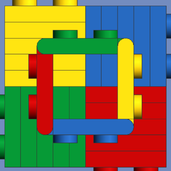Search the Community
Showing results for tags 'Linear Actuator'.
Found 11 results
-
(1).thumb.png.b4d6c907fe73903aec1adfd3cd481a19.png)
linear actuator degrees to full length
glowytheglowbug posted a topic in LEGO Technic, Mindstorms, Model Team and Scale Modeling
just a simple place to deposit how many degrees it takes from the input to fully extend and contract a linear actuator (ill be posting them soon) -
(1).thumb.png.b4d6c907fe73903aec1adfd3cd481a19.png)
First? linear actuator engine I4
glowytheglowbug posted a topic in LEGO Technic, Mindstorms, Model Team and Scale Modeling
uses spike for programming and there are 2 versions using small and medium linear actuators, the code isnt perfect though and the small one skips easily, getting carbon axles for better accuracy when retracting and expanding the actuators so i dont get a big explosion of actuators and twisted axles again one medium actuator suffered :( planning to get some metal uni joints for turning this into some crawler beast- 18 replies
-
- linear actuator
- technic
-
(and 5 more)
Tagged with:
-

[Studio] Technic Linear Actuators in Studio HELP - SOLVED
MajklSpajkl posted a topic in Digital LEGO: Tools, Techniques, and Projects
Hello everyone, I was looking over the forum whether same question has been already posted somewhere, but couldn't find it, so I hope I am not doubling the topic: Q1: Is there a possibility to extend or shorten the technic linear actuators (92693c01, 61927c01 and 40918c01) in stud.io? Are there at least parts made of those in shortest and longest state and where can they be found? Q2: Is there a tool or a trick to align two i.e. liftarms, each with its own fixed pivot point to a position where those two cross (like two circles crossing each other) - is it possible to find that exact crossing in stud.io? I am putting most of my hopes into @efferman, @Zerobricks and @M_longer as I've seen quite a lot of great digital stuff coming from them. I would really appreciate any help from any other who might know something about it as well. I thank you in advance, Best regards, Miha -
hello everyone, sorry for long title but I do not know a proper way of asking this. I have a problem at hand: I wanted to use a small linear actuator to lift something. I am building a truck and want to lift the second rear axle like real trucks do. I put a linear actuator in a horizontal position and hoped to lift the axle in a mechanism as you can see in LXF below (red axle is the one I am trying to raise). https://www.bricksafe.com/files/scynox/temp/truck_axle_lift_problem.lxf I had to see the movement in real and built it but I saw that it will not work. as linear actuator is extended, the spring is put into a weird angle and eventually it starts bending. I only need to raise axle one or one+half stud so I did not care about a little illegal movement. Is there a better way of using a horizontal placed linear actuator to "raise" sth in vertical direction? Is there a general solution for such a problem? thanks
-

[WIP] 1:50 NASA Crawler Transporter
OzShan posted a topic in LEGO Technic, Mindstorms, Model Team and Scale Modeling
I am getting close to the end of this long term build and it's time to share some pictures and a bit of the story. Even before I had finished putting together 10231, I decided I wanted a Crawler to go with it. Being a Technic fan it had to at least drive around and lift the launch platform and shuttle. Those two basic goals spawned a project that has lasted a little over 2 years so far. Some ideas have stuck around since their inception, others were a bit optimistic (like building a peristaltic pump and hoping I could find a way to control the pneumatics hydraulically). February this year marked the 50th anniversary of when the two crawlers went into service, so recently there has been extra motivation to finish. The base equipment; - 16x M-motors (drive) - 4x L-motors (pneumatic jacking and leveling) - 4x IR Receivers (V1 as the V2s do not like driving multiple m-motors on a single channel) - 4x NXT servo motors (steering) - 4x RCX rotation sensors (measuring jacking level between truck and chassis) - 2x NXT bricks (one master and one slave. The master communicates with the Android Tablet and coordinates itself with the slave. Programmed in LeJOS) - 1x PF IR-Link sensor (link between master NXT and all PF motors) - 2x PF Battery boxes (with thermal overload removed) - 1x Android Tablet Future add-ons - Accelerometer (automatically detect the crawler is on a gradient and adjust the leveling to suit) Bricksafe folder is here: http://www.bricksafe.com/pages/OzShan/Crawler Firstly, a couple of my favorite reference pictures; The build itself started with the trucks, thinking that the pneumatics and LAs would dictate the scale. First proof of concept - build a coupling to give height, pitch, roll and yaw to the truck. The pneumatics need to be on their own gimbals too. The reinforced 2x2 rounds slide and rotate in the 4x4 macaroni's. It is on the limit of what will hold together without glue, but it does hold. The two 1x2 technic bricks at the base of the 2x2 column are helped a little by a string (not pictured) which runs up through the 2x2 rounds with the axle. Initial prototype of the drivetrain. I would have liked a higher ratio but there was just no room at this scale. When the gearbox was married with the truck chassis I had to juggle positions, so you will see in later pics the crown gears are facing in not out Best laid plans.... Marry studded and studless they said. It will be easy they said... Showing what will eventually be the steering between chassis and truck. The guide tube and pneumatic cylinders are all on gimbals with the pneumatics coupled together. The average height is preserved during any tilting. With prototypes sorted, it's time to bricklink some parts and quieten down the colour scheme! (thank you 42030 for providing 5L thin liftarms with axle hole in LBG color) You can see the relationship between "guide tube" and cylinders here. The pneumatic system was overhauled too many times to remember but this is what it arrived at. It is all controlled by the direction of the motor. Running forwards drives the pump. When running backwards, the lobes operate the pneumatic valves in series, letting small amounts of air escape each rotation. This lowers the chassis in a slow and controlled manner. The motor can be turned on or off and run in either direction at any time due to the valve timing. Early attempts with PF Servo and NXT servo just couldn't park the valve reliably and after a few operations I would hear a slow leak. I have been trying to keep up with the LDD but it's hard to stay motivated when I know I'm just going to have to suck it up and move over to LDraw if I want to include all the motors, pneumatics and LAs Works so far; (I'll make the files available if anybody would like them). I found LDD essential in the early days to plan ahead and simply find parts, but later on the build overtook it. Original 'box' pump. 1x PF XL motor, 4x 6L pumps running at 90 deg to each other. Very smooth but bulky. Flatter attempt in the same vein. The truck itself. The final design for the height control modules. I hope you enjoy the build so far. More pictures to come of chassis, steering, leveling and interior details. I'll leave it to others to decide what 'theme' it belongs to .- 73 replies
-
- Power functions
- NXT
-
(and 5 more)
Tagged with:
-

Linear Actuator Clicking
SNIPE posted a topic in LEGO Technic, Mindstorms, Model Team and Scale Modeling
Hi, I have just finished working on a mock-up landing gear deployment mechanism, keeping it as simple as possible of course. However one thing that I cannot seem to get rid of, is the small linear actuator's built-in overload protector from clicking. I have tried to add a white clutch gear meshed to an 8 tooth gear in either 3:1 or 1:3 ratios but it still clicks. If I use a 3:1 ratio the clicking and vibrations are obviously much more rapid than otherwise. To save space, I insisted on having a fixed, almost parallel LA rather than the typical design where the LA is also pivoting like a lift-arm. The wheels must be retracted by 90 degrees (you'll see this if you build it/watch the video) Does anyone have any ideas on how to eliminate this whilst keeping it simple? I tried replacing the 2 x 4 bent lift-arms with a what equates to 1.5 length lift-arms so that the LA does not fully retract and start clicking but then it does not do a full 90 degrees of movement and starts bending parts if I force it. Here is an .LXF file and below is a video showing what I mean: I'll be able to shorten or remove some beams soon to make it less clunky. -

[HELP] Abilities of Lego Linear Actuators
lol1419 posted a topic in LEGO Technic, Mindstorms, Model Team and Scale Modeling
Hello everyone, I'm new here and this is my first post. Forgive me if I seem a bit primitive in my knowledge of LEGO's. I was planning to use some linear actuators but I got two questions about them. 1) How long do they come? Is there anyway I could mod it to allow a larger stroke? (e.g. 2"/3"/4") 2)At a given point in their travel (i.e at very top of stroke) can they "lock" in place or hold a relatively large amount of weight (e.g. 1lb) WITHOUT the motor running? Thanks, -lol1419- 20 replies
-

Geometry calculations for Linear Actuators
Countdown posted a topic in LEGO Technic, Mindstorms, Model Team and Scale Modeling
Hi community, Is there a resource available for calculating the kinematics of the LA's? Some kind of a computerized solver where you put a initial condition, the stroke of a cylinder, the length, the final angle of rotation or degree needed? Or some program to solve or simulate the kinematics of 3 and 4 point linkage? For example, here's my problem: I want to raise a boom from -10 to 90 deg. What would be the ideal configuration in studless with large LA's? Unfortunately, my laptop can't handle SR3D; is there something else? Thanks -

8052 container truck hook mechanism
arik posted a topic in LEGO Technic, Mindstorms, Model Team and Scale Modeling
Hi, I've just built 8052 from parts from other sets, mostly according to instructions. I had to change a couple of details, but nothing functional, except substituting the 24t gear with the white clutch gear. However, when I unload and load the container from/to the truck using the clever hook mechanism, the hook doesn't get sufficiently low for easily attaching or detaching the container. It stays maybe one stud too high. If gently pressed down, it can slide under the container attachment point. Do you have the same problem? It's not a big issue, but I've seen a YouTube video where the truck just unloads the container and then "drives" away. I was sure there was some kind of mistake when building the truck, but I cannot spot it. The only thing I can think of is if the linear actuator behaves differently: if it only extended a couple mm longer, it would be fine. Surely the clutch gear cannot be the reason? (Now the LA internal clutch doesn't engage, but I don't think correct operation of the model would depend on that...) If this not a common problem, maybe I should post a pic or two, if you can spot the error/reason... -
Mini linear actuators are technic parts that mimic hydraulic cylinders and convert rotary motion into linear motion. They are primarily used in combination with power functions to perform minor mechanical tasks, but their scale suggests that they could be used to mechanize smaller town models as well, though I haven't found anything after a cursory search on this forum. I made these two models to show a couple of examples of how they may be used. The excavator arm and dump truck tipping mechanism both use mini linear actuators to add mechanical complexity to otherwise small and compact models. Here they are from another angle. Here the mechanics of the excavator are exposed. The boom is operated through a worm gear mechnism by the knob on the left of the "counterweight", and the arm is extended with the one on the right. Both mechanisms are geared so that two full revolutions of the knobs is sufficient for the full range of motion. I hope others might find these parts and techniques useful in their own builds!
- 9 replies
-
- linear actuator
- construction
-
(and 3 more)
Tagged with:
-
Here's my new rather simple MOC. Because doing a simple dump truck is well....simple, I decided to spice things up by adding suspension and using only 2 motors to do 3 functions. So how can you use 2 motors for three functions? The answer is rather simple. I used a differential connected to steering system. As soon as the steering rack reaches its maximum position, the power is diverted to the LA, which lifts the bed. In order to make sure that the steering will always work before the LA i Used some friction pins parallel to the LA functions, to make sure the differential will always steer first. The brown gears are from the drive motor. The red ones are froms teering motor. The green diff splits the power where it is needed. After building this central gear system, there was another problem to solve. The LA is stuated in such manner, simply pushing agaisnt the bed would be very inefficient when trying to lift heavy loads. After some trial and error i came up with this special linkage, which follows the circular path of the bed, therebye helping it lift, instead of just pushing against it. The LA in green pushes the brown link, which in turns lifts the bed. The small blue and yellow links are used to make the brown link follow a certain path in which it not only pushes, but also lifts the bed, therebye creating more force. After adding a tiltable cab, battery box and suspension the truck was done: I used independent suspension for first and rear axle, whilethe second driveaxle uses double tyres and live axle suspension. The second axle is also configured in such way to carry most of the rear weight. The cab can be lifted to reveal the receiver. And a short video of the truck in action: http://www.youtube.com/watch?v=R9wvAlX7Z-U All in all its a nifty little truck and very fun to drive arround and dump stuff out, especially bricks. Also by just using 2 motors and only one IR channel, this allows for more RC models to be driven at once like on exhibitions, etc,... I also made the model in LDD if anyone is interested: http://www.brickshel...ruck/dumper.lxf P.s. MOD its dump truck, not Sump truck, please correct the topic name.
- 12 replies
-
- zblj
- suspension
-
(and 2 more)
Tagged with:



